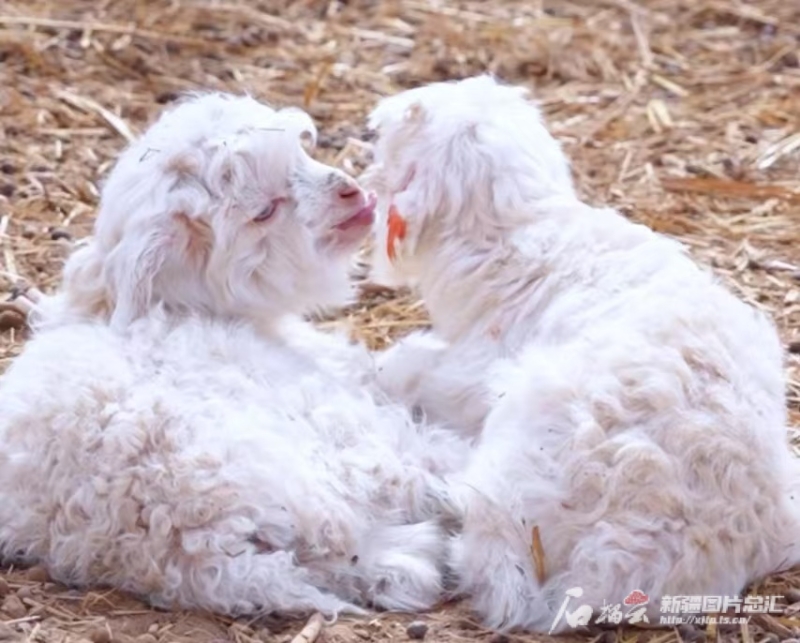Shiliuyun-Xinjiang Daily (Reporter Ma Boyu) news: As spring arrives, a new batch of lambs and calves is born.

Photo taken on February 18, 2025 shows under the warm spring sun, two newborn lambs nestled against each other in the pasture of Tarim Town, Kuqa City, Aksu Prefecture, northwest China’s Xinjiang Uygur Autonomous Region. (Photo provided by the Media Convergence Center of Kuqa City)
This period is crucial for spring lamb production. To effectively improve the survival rates of lambs and calves while increasing the income of farmers and herders, various localities in northwest China’s Xinjiang Uygur Autonomous Region are systematically promoting immunization against major animal diseases in the spring and providing technical service guidance for lambing and rearing. So far, 12.15 million lambs and calves have been produced throughout the region.
In the sheep shed of Zhai Jianming, a farmer from Tacheng Prefecture, 100 newly born lambs curiously explore their surroundings. In Keping County, Aksu Prefecture, 13,000 female camels are in the midst of their breeding season. Meanwhile, in the warm enclosure of Qiemuerqieke Town, Altay City, lambs are snuggling up to their ewes, attempting to stand for the first time. The arrival of these new lives is supported by dedicated technicians.
During the transition from winter to spring, the autonomous region organized more than 60 professional technicians to carry out epidemic prevention and control measures to improve the survival rates of lambs across 14 prefectures and cities. There have been over 90 on-site training sessions, and more than 12,700 masks, latex gloves, and protective clothing have been distributed.
Kizilsu Kirgiz Autonomous Prefecture has implemented various measures to accelerate the breeding of improved breeds. to enhance the reproductive rates of sheep. They focus on artificial insemination technology and promote efficient breeding methods such as early weaning, estrus synchronization, and B-ultrasound for early pregnancy diagnosis to achieve positive results.
Keping County employs a government-enterprise collaborative model to organize technicians who work closely with farmers to guide scientific breeding practices. Under their guidance, farmers are preparing "confinement meals" to supplement the strength and nutrition of female camels.
"My family has 60 sheep, 55 of which are ewes. This time, all are using artificial insemination, and currently, 90 percent of the ewes have lambed," said Bielieke Afuxi, a herdsman in Halaqi Village, Akqi County, on February 24, 2025.
Tuoli Town in Jinghe County is also experiencing the peak period of calf production. Herdsmen are busy assisting with the births of new calves. Lu Buyundailigeer has been using warm pens for his cattle for the past two years. He has also prepared enough forage and has implemented strong disease prevention measures for his cows, ensuring that he has a range of preventive medicines on hand. Under the guidance of technicians, his calves are in good condition this year.
"My family owns 80 cows, and we have completed their vaccinations. We also purchased insurance for the cattle, which provides greater security," said Lu Buyundailigeer.

Photo taken on February 18, 2025 shows a local girl with a lamb in the pasture of Tarim Town, Kuqa City, Aksu Prefecture, northwest China’s Xinjiang Uygur Autonomous Region. (Photo provided by the Media Convergence Center of Kuqa City)
In recent years, Xinjiang has actively promoted key measures for transforming animal husbandry practice. The efforts are aimed at ensuring timely breeding of female animals and improving reproductive rates by utilizing technologies like synchronous estrus and artificial insemination. In 2024, over 2.8 million sheep completed artificial insemination and economic crossbreeding, an increase of 180 percent compared to the previous year. Additionally, 1.5 million cattle breeds have been improved by artificial insemination using frozen-thawed semen, showing a 25 percent increase from the prior year.
During the winter and spring seasons, various localities in Xinjiang pay attention to the forecasts from meteorological departments and implement essential measures, including forage reserves, herd grazing management, and supplementary feeding for livestock.
Currently, Xinjiang has established over 160 four-level (regional, prefectural, county, and township) forage reserves for disaster prevention, with an annual reserve of more than 600,000 tons of emergency forage. During the cold wave in early 2025, key areas such as Ili Kazak Autonomous Prefecture, Altay Prefecture, Tacheng Prefecture, Bortala Mongolian Autonomous Prefecture, Bayingolin Mongolian Autonomous Prefecture, and Aksu Prefecture responded effectively. They cleared 2,166 km of pastoral roads, relocated 52,000 livestock, and transported 21,000 tons of emergency forage for disaster prevention.
Additionally, a total of 1,180 experts and technicians were dispatched to assess and eliminate potential risks on the front line. They provided services including supplementary feeding for livestock, cold prevention, warmth preservation, and support in repairing and reinforcing 810 barns, thus ensuring the safe overwintering of livestock. Furthermore, efforts to conduct thorough censuses of livestock and poultry stocks, determine vaccination needs, and strengthen immunization practices are ongoing to guarantee the quality and coverage of immunization.
It is projected that the work of raising lambs in spring will continue until the end of March. Going forward, agricultural and rural departments at all levels in Xinjiang will leverage scientific and technological advancements to ensure the safety of animal husbandry production and maintain a stable and secure supply of animal products in the market.
(A written permission shall be obtained for reprinting, excerpting, copying and mirroring of the contents published on this website. Unauthorized aforementioned act shall be deemed an infringement, of which the actor shall be held accountable under the law.)









